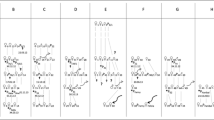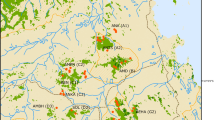Summary
A unified model of social organization, spatial distribution, and demographic parameters in the bank vole was developed. It is based on social relations among females, among males and also between reproductive females and males. In the model, social status and reproductive condition of an individual depend exclusively on interactions with its nearest neighbours. A result of interactions between two neighbours remains “local”, i.e., it cannot affect other, more distant individuals. The simulated variables show similar trend and scatter as those found in a growing real population of the bank vole. The relevance of the model for theories of population dynamics is discussed.
Similar content being viewed by others
References
Boer PJ den (1968) Spreading of risk and stabilization of animal numbers. Acta Biotheor 18:165–194
Boer PJ den (1985) Fluctuations of density and survival of carabid populations. Oecologia 67:322–330
Bujalska G (1970) Reproduction stabilizing elements in an island population ofClethrionomys glareolus (Schreber 1780). Acta Theriol 15:381–412
Bujalska G (1973) The role of spacing behaviour among females in the regulation of reproduction in the bank vole. J Repr Fert [Suppl] 19:463–472
Bujalska G (1975) The effect of supplementary food on some parameters in an island population ofClethrionomys glareolus (Schreber 1780). Bull Acad Pol Sci, Ser Sci Biol Cl II, 23:23–28
Bujalska G (1983) Reproduction. In: Petrusewicz K (ed) Ecology of the bank vole. Acta Theriol 28, [Suppl] 1:148–161
Bujalska G (1985a) Fluctuations in an island bank vole population in the light of the study on its organization. Acta Theriol 30:3–49
Bujalska G (1985b) Regulation of female maturation inClethrionomys species, with special reference to an island population ofC. glareolus. Ann Zool Fennici 22:331–342
Bujalska G (1985c) Sex ratio in an island population ofClethrionomys glareolus. Acta Theriol 31:71–78
Bujalska G (1988) Life history consequences of territoriality in the bank vole. In: Boyce MS (ed) Evolution of life histories of mammals. Yale University Press, New Haven, pp 75–90
Bujalska G, Janion SM (1981) Bank vole response to an increase of environmental capacity. bull Acad Pol Sci, Ser Sci Biol, Cl II, 29:129–133
Bujalska G, Mieszkowska D (1984) Distribution of individuals and captures in an island population of the bank vole. Acta Theriol 29:147–158
Bujalska G, Andrzejewski R, Petrusewicz K (1968) Productivity investigations of an island population ofClethrionomys glareolus (Schreber 1780). II Natality. Acta Theriol 17:33–40
Burt WH (1943) Territoriality and home range concepts as applied to mammals. J Mammal 24:346–352
Christian JJ (1956) Adrenal and reproductive responses to population size in mice from freely growing populations. Ecology 37:258–273
Grüm L (1988) W sprawie pojecia “areal osobniczy” i zasad prownywania jego charakterystyki (On the “home range” concept and principles of comparability of its aspect estimates). Wiad Ekol 39:61–71
Holling CS (1966) The functional response of invertebrate predators to prey density. Mem Ent Soc Canada 48:1–86
Karlsson AF (1986) Effect of conspecifics on winter movements and dispersion in an overwintering bank vole (Clethrionomys glareolus) population. Can J Zool 64:593–598
Lloyd M (1967) “Mean crowding”. J Anim Ecol 36:1–30
Mazurkiewicz M (1971) Shape, size and distribution of home ranges ofClethrionomys glareolus (Schreber 1780). Acta Theriol 16:23–60
Petrusewicz K (1963) Population growth induced by disturbance in ecological structure of the population. Ekol Pol, Ser A 11:87–125
Stenseth NC (1985) Models of bank vole and wood mouse populations. In: Flowedew JR, Gurnell J, Gipps JWH (eds) The ecology of woodland rodents, bank voles and wood mice. Zool Soc Symp Lond 55:339–376
Tanaka R (1953) Home ranges and territories in aClethrionomys population on a peat-bog grassland in Hokkaido. Bull Kochi Wom Coll 2:10–20
Viitala J (1977) Social organization in cyclic subrctic population of the volesClethrionomys rufocanus (Sund.) andMicrotus agrestis (L.). Ann Zool Fennici 14:53–93
Wierzbowska T (1972) Statistical estimation of bome range size of small rodents. Ekol Pol, Ser A, 20:781–831
Wierzbowska T (1975) Review of methods for estimating the parameters of the home range of small rodents from aspect of sample size. Acta Theriol 20:3–22
Wiger R (1979) Demography of a cyclic population of the bank vole,Clethrionomys glareolus. Oikos 35:373–385
Wolton RJ, Flowerdew JR (1985) Spatial distribution and movements of wood mice, yellow-necked mice, and bank voles. In: Flowerdew JR, Gurnell J, Gipps JWH (eds) The ecology of woodland rodents, bank voles and wood mice. Zool Soc Symp London 55:249–275
Author information
Authors and Affiliations
Rights and permissions
About this article
Cite this article
Bujalska, G., Grüm, L. Social organization of the bank vole (Clethrionomys glareolus, Schreber 1780) and its demographic consequences: a model. Oecologia 80, 70–81 (1989). https://doi.org/10.1007/BF00789934
Received:
Published:
Issue Date:
DOI: https://doi.org/10.1007/BF00789934




